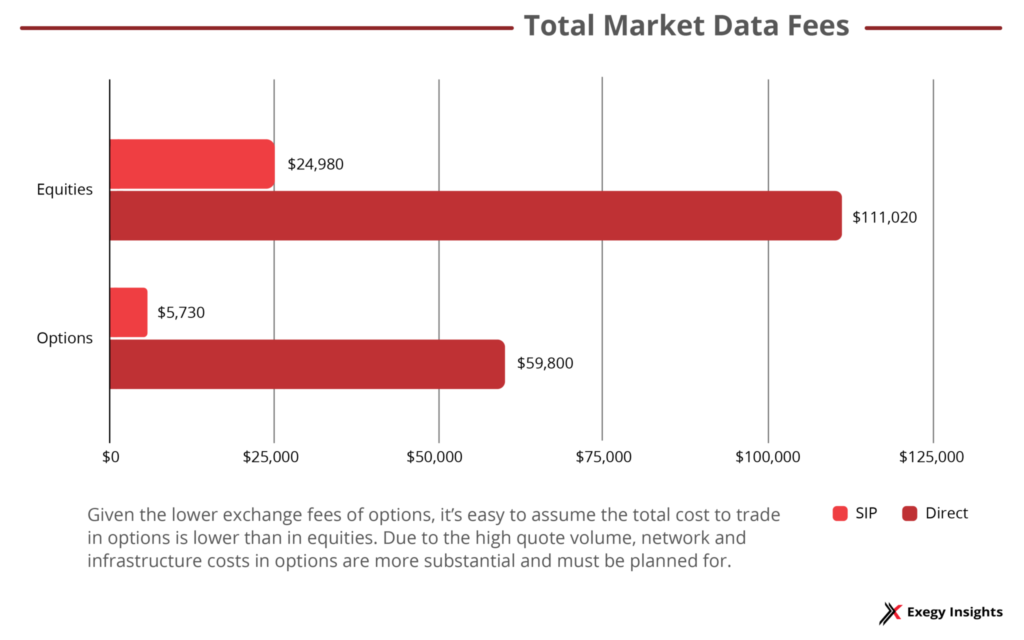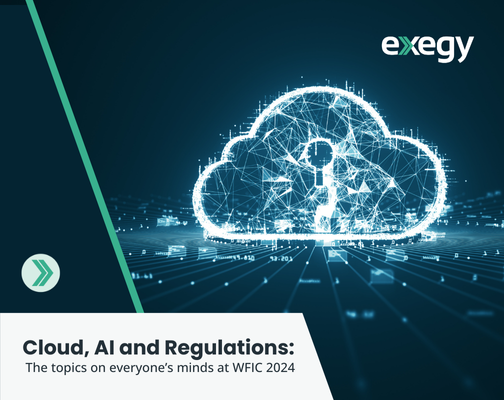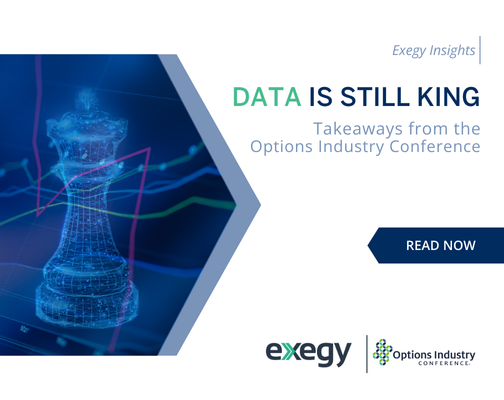Understanding the Impact of Options Market Data Costs
Market data for options is commonly believed to be less expensive than equities. While exchange fees can be lower, they do not represent the entire picture. Options trading often involves infrastructure costs that can offset the savings gained from lower exchange fees. To add needed clarity to the total costs involved in options trading, this article explains the hidden costs of options trading.
Options Exchange Fees
The Options Price Reporting Authority (OPRA) and its consolidated options feed offers a clear example of option market data’s low exchange fees. As the options Security Information Processor (SIP), OPRA distributes all top-of-book and last sale tick data from options market participants. A quick comparison to the equities consolidated feeds—the Consolidated Tape Association and Unlisted Trading Privileges—demonstrates that the fees for Level 1 access to options data are far less than comparable access to equities data.
Table 1. Market data fees for equities and options SIP feeds*
| Network / Tape | Access Fee | Non-Display Fee | Redistribution Fee | User Fee (per 20 devices) | Total | |
| Direct | Indirect | |||||
| CTA (Tapes A & B) | 5,000 | 3,000 | 6,000 | 2,000 | 1,000 | 17,000 |
| UTP (Tape C) | 2,500 | 500 | 3,500 | 1,000 | 480 | 7,980 |
| OPRA | 1,000 | 600 | 2,000 | 1,500 | 630 | 5,730 |
With direct feeds, the contrast between equities and options is more nuanced. Equities exchange fees are infamously exorbitant, with some non-display fees surpassing $30,000 per month. In total, fees for direct feeds from equities exchanges can be more than 50% higher than those from options for the same exchange families. With some exception, exchange fees for options trading will be lower cost than for equities trading.
Table 2. Market data fees for equities and options direct feeds*
| Asset Class | Exchanges & Feeds | Access Fee | Non-Display Fee for Category 1 | Redistribution Fee | User Fee (per 20 Devices) | Total | |
| Internal | External | ||||||
| NYSE | |||||||
| Equities | NYSE, American, ARCA, National Integrated | 13,000 | 35,500 | NA | 9,250 | 2,800 | 60,550 |
| Options | American, ARCA Options | 6,000 | 10,000 | NA | 4,000 | 2,000 | 22,000 |
| Nasdaq | |||||||
| Equities | Nasdaq, BX, PSX TotalView | 5,000 | 7,100 | 2,750 | 6,500 | 3,120 | 24,470 |
| Options | Nasdaq Options, BX, GEMX, ISE, MRX, PHLX | NA | NA | 13,500 | 1,500 | 3,000 | 18,000 |
| CBOE | |||||||
| Equities | BZX, BYX, EDGX, EDGA Depth | NA | 6,000 | 5,500 | 12,500 | 2,000 | 26,000 |
| Options | Cboe, C2 Book Depth; BZX, EDGX Options Depth | 11,500 | NA | 3,500 | 2,500 | 2,300 | 19,800 |

Key Difference Between Options and Equities
Given the lower exchange fees of options, it’s easy to assume the total cost to trade in options is lower than in equities. This is not always the case. Exchange fees are just one small part of the total costs of options market data. Market data fees must also account for the network and infrastructure costs necessary to process all the options trading data.
Options generate a much higher volume of data compared to equities simply due to the structure of the asset. In equities, the volume of products is relatively limited to the number of publicly listed companies and securitized funds. For options, products are limitless due to the combinations of puts, calls, expiration dates, and strike prices. In addition, as derivatives of equities, the price of an options contract fluctuates with changes to the underlying asset’s price. Each tick in equities generates a new fair price on every derived contract and motivates traders to update their resting limit orders accordingly. In turn, options instruments produce an incredible mass of data, and this mass of data must be managed and processed.
The True Costs of Options
To get a better idea of the true costs of options, it is best to look at the most commonly used data feed: the OPRA feed. OPRA provides each exchange’s best bids and offers and computes the national best bid and offer (NBBO) from those, presenting a good baseline for understanding costs.
Due to the high volume of data involved in the OPRA feed, network and other infrastructure costs can soar. To handle all of OPRA, a firm needs a 40-gig network to prevent buffering or dropped packets of data. Having that capacity in-house—requiring switches, ticker plants and feed handlers, and trading application servers—could incur capital expenditures upwards of $200,000.
In addition to these infrastructure costs, accessing the OPRA feed directly from OPRA requires a firm to purchase port access to the NYSE SFTI Network. Since the Securities Industry Automation Corporation (SIAC)—the managing organization of OPRA along with CTA—is a subsidiary of NYSE, it is integrated into NYSE’s infrastructure and distributes the market data from their network. This mandatory port fee for OPRA is $20,000 in recurring monthly costs on top of a one-time $15,000 fee. For redundancy purposes, a second port is often necessary, doubling the costs for NYSE SFTI network access.
For direct feeds, especially order books with their greater depth of data, infrastructure and handling costs will most often be comparable or greater than those for OPRA.
Selecting an Options Market Data Solution
There are several methods available for managing an options market data infrastructure. They range in their cost efficiency, customizability, and latency. A subscription service or a hosted and managed solution can substantially lower the costs to access and maintain options feeds, however, some sacrifices of customizability and latency optimization may be incurred.
Custom Infrastructure
A custom infrastructure is the highest cost option. With an entirely custom infrastructure, a firm takes on all or most of the hardware and software development and maintenance costs for their data infrastructure. They devote substantial employee time and energy towards maintaining this infrastructure. Further, a firm pursuing this option is responsible for all exchange and network fees in their entirety. The benefit of a custom infrastructure is that it offers every opportunity for customization to a firm’s specific strategy and optimization of their latency.
Hosted or Managed Infrastructure
A hosted or managed infrastructure offers many of the advantages of a custom infrastructure, like opportunities for latency optimization and substantial customizability. These advantages vary by provider and solution, with some offering more customization for conflation rates or latency than others. With a hosted or managed solution, a firm pays a vendor to develop and install the necessary hardware for the given firm’s market data needs. Most typically this involves ticker plants, servers, and network considerations. This vendor will also maintain feed handlers as part of their managed service. This eliminates the need to devote development and operations staff time, allowing better team utilization on core business functions.
With a managed solutions like the Exegy Ticker Plant or its hosted version, firms can save money by better utilizing their employees and by eliminating the costs to develop and install the infrastructure hardware from scratch.
Subscription Solution
With a subscription solution, a firm receives access to specific data feeds through an API connection with no infrastructure management. This is the most cost-efficient option as it outsources the hardware and maintenance to the subscription provider with no capital expense. Instead, the entire market data infrastructure is handled by the provider. This solution also cuts down on network fees, like those for the SFTI Network, by distributing them across subscribers.
A subscription solution is typically not the lowest latency nor the most customizable, though these factors will vary slightly depending on the options offered by the subscription provider.
With an understanding of the true costs of trading options, firms are better able to select the options market data solutions that best fit their market data needs. They are also better equipped to understand the price-points and value of hosted, managed, subscription, and custom solutions. However, there are still other factors to consider when selecting a market data solution. For more guidance on which solution is right for your firm, request a consultation with an expert at Exegy.
*Fees are aggregates of the order book feeds of the exchanges listed. This table is not meant to be an exact representation of what your company will be charged in market data fees. Fees are subject to updates from the exchanges. Check on exchange websites for up-to-date pricing. Fees are assessed at the discretion of your account manager.




